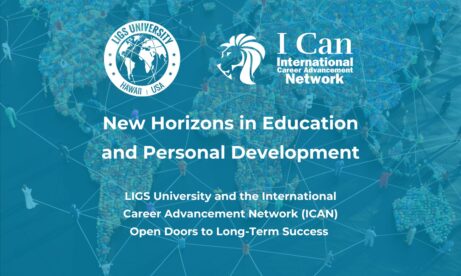
Implementation of Remote Work Culture for Organizational Efficiency in Selected Business Organizations in Calabar, Cross River State, Nigeria
Dynamics in business environment through COVID-19 pandemic have influenced the implementation of remote working in developing countries more than before; and HR professionals, CEOs, and experts have now reviewed the necessity of working remotely as being productive, and enforcing new processes aimed at checking employee output in many organizations (Moss, 2020). The increasing popularity of remote working is a new normal caused by social distancing as a safety measure for controlling the spread of the COVID-19 virus in the workplace and society at large (Sucheran & Olanrewaju, 2021, p. 12). Today, the emergence of COVID-19 has imposed the importance of remote work culture as a standard requirement for organizational continuity in an uncertain business environment. Remote work is inevitably imposed on many organizations as a strategic practice to undermine the effect of the COVID-19 pandemic (Spicer, 2020, p.1738). Researchers have predicted the implementation of remote work based on advantages and disadvantages, the geometric increase in remote work is strategically considered a potential for future work life by organizational leaders (Ozimek, 2021, p. 1; Klopotex, 2017, p. 1; Madsen, 2011, p. 10).
With many organizations across the globe, there is increasing use of remote work, while others are increasingly sustaining the remote work practice irrespective of the pandemic (Asatiani, 2021, p. 65). However, the need for organizational efficiency requires remote work as a practice which has not been a priority for many organizations in Nigeria. This has generated development as workers become adapted to the new normal of enhancing efficiency in the organization. In Nigeria, it is apparent that the COVID-19 pandemic has raised concern for remote work which is gradually adopted and many organizations are adjusting their HR policies to cope with the realities of a new work pattern for excellent performance (Andriyanty et al., 2021, p. 530). However, the implementation of remote work in the areas of insurance, professional services, media, finance, manufacturing, education etc have gradually becomes a sustained practice. Therefore, the increasingly global competitive market supports remote work as a crucial organizational tool that enhances sustainable performance (Kowalski & Slebarska, 2022, p. 9). Many organizations have given priority to effective work-life balance job satisfaction and reduction on commuting. These are influenced by the technological advancement which promotes remote work culture. As a contemporary practice by many organizations, it has overtimes reduced operational costs and offers improvement and accessibility to a skilled workforce. With this recognition, this study aimed at examining the implementation of remote work culture on organizational efficiency in selected business organizations in Calabar, Cross River State
Statement of the problem
It is evident that remote work is less explored in Nigeria, and the implementation of remote work culture in an organization is influenced by well-being risks and benefits in which efficiency and productivity are necessary to achieve organizational goals. The importance of preserving occupational health and productivity has been a concern for organizational leaders to align HR policy to cope with the impact of the changing environment imposed by COVID-19 (Bouziri et al., 2020, p. 25; Toniolo-Barrios, 2020, p. 8). Before the adoption of remote work, many organizations lack adequate planning which made homes become shared workplaces, difficulties in concentration due to ambient distraction of noise, and the absent of adequate technology, lack of adequate infrastructure and systems to work remotely affected remote work practice among many competitive organizations. To sustain work-life balance and job satisfaction of the employee, the adoption of remote work among organizations in various countries is dependent on the level of the internet infrastructure, increasing use of bandwidth, and a spike in digital traffic (Sucheran & Olanrewaju, 2021, p. 9). Also, the lack of self-discipline in work with little supervision may be a challenge to workers who undertake remote work. However, the success of this is based on setting priorities and designing, and implementing remote work policies in the organization. As a result of this inadequacies, this study examines the implementation of remote work culture on organizational efficiency in Selected business organizations in Calabar, Cross River State
Objectives of the study
The study aimed was to examine the implementation of remote work culture on organizational efficiency in selected business organization in Calabar, Cross River State. The objectives are to:
- Assess how work-life balance influences organizational efficiency in selected business organizations in Calabar, Cross River State
- Examine how job satisfaction influences organizational efficiency in selected business organizations in Calabar, Cross River State
Research questions
- Does work-life balance influences organizational efficiency in selected business organizations in Calabar, Cross River State
- How does job satisfaction influences organizational efficiency in selected business organizations in Calabar, Cross River State
Conceptions on remote work
Technological advancement has a significant contribution to the popularity of remote work in the 21st century and its implementation is influenced by the emergence of the COVID-19 pandemic. As a concept, it implies teleworking aimed at reducing traveling times for workers. It also connotes ‘Flexiplace’ where work is carried out away from the employee home and made possible through the technological advancement in networks and the internet (Chow & Keng-Howe, 2006). Similarly, it is viewed as work-at-home in which task is performed away from the confine of the organization. Remote work relates to work outside the standard office setting of the organization. In support, Sucheran and Olanrewaju (2021. p. 12) define it as work executed from various locations which require the use of information technology to access information.
The adoption of remote work is influenced by the need for an organization to save costs, increase productivity, recruit and retain workers, availability of jobs for an individual that is disabled, reduction in commuting time, flexibility in working time, work-life balance, quality of life, increase autonomy, less distraction, less stress, and job satisfaction (Madsen, 2011, p. 8). On the other hand, social and professional isolation of co-workers, increase in working hours, lack of work-life balance, low participation in organizational culture, limitations in verbal communication, etc have been identified as disadvantages of remote work (Klopotek, 2017, p. 1).
A study by Sok et al (2014, p. 458) shows the importance of remote working. For instance, there is an increase of 13 percent in working from home in China. Therefore, working remotely has become an enabler tool for sustaining the efficiency of an organization at a given time. The readiness and applicability of remote work among organizations and across the globe vary (Sucheran & Olanrewaju, 2021, p. 7) though it is linked increase productivity, less interruption, and distraction in the office, less traveling time, having more time for family, and flexibility in the working environment. However, findings European Commission revealed that in Finland, remote working was over 37 percent implemented in 2020; in the EU an average of 12 percent of people worked remotely during the pandemic; in the US, the study revealed that over 35 percent of work was done remotely (Brynjolfsson 2020, p.1). A survey by Johnson and Suskewicz (2020, p. 1) revealed that the CEO of Twitter has admitted their employees to work from where they considered most preferable to work from. In addition, over 50 percent of the Facebook workforce will be allowed to work remotely (Davis & Myers, 2019, p.570). A study by Brenan (2020, p. 1) revealed a 65 percent of workers accepted to continue remote work in the long term which implies that that it is imminent in contemporary society (Kowalski & Slebarska, 2022, p. 7). In Europe, policies that promote flexible working were formulated to encourage flexible work being mandated by European Union policy on flexible work arrangements. To ascertain the extent of organizational efficiency in adopting remote work, Parungao (2020, p. 1) predicted that working from home has become a permanent rather than temporal practice. This has made organizational efficiency to be enhanced through the use of technology, and efficient operations are sustained through the introduction of remote work policies. Sequel to this, a study by Mason (2020, p. 1) revealed an increased in autonomy, a dearth in daily commuting, and an environment that supports productivity having a positive effect on working from home.
Theoretical framework
This study adopted Social Exchange Theory to guide the study. The theory stressed that exchanges exist between people where costs can be traded to have a reward. In Social Exchange Theory, profit is accrued through exchanges. However, a perceived feeling of inequity in the exchange may arise when receiving rewards that are more than the cost (Chernyak-Hai & Rabenu, 2018, p. 26). This theory applies to the relationship between employer and employee when there is the involvement of remote work.
The implication of this theory to the study is that both employers and employees embrace profit by working remotely, and some of the ways of enhancing profitability by an employee are through scheduled flexibility of work, and effective work-life balance. On the other hand, the employer enjoys cost advantages as profit. However, remote work being influenced by the pandemic made employees and employer have shared profit. Hence, by maintaining safety standards employee can benefit from continued employment, and employer benefits as employee continuously works with support for the growth of the organization.
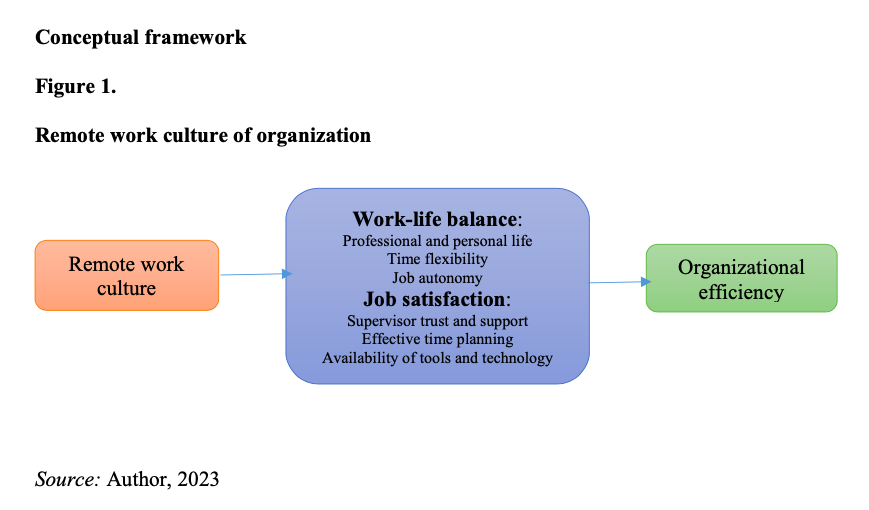
Work-life balance and organizational efficiency
Work-life balance as an organizational philosophy is implemented through work from the home policy of an organization (Andriyanty et al., 2021, p.525). The desire to achieve harmony and balance between work responsibility and the life of an employee requires remote working. Conceptually, work-life balance implies equilibrium to ensure that the personal life and work of the employee is equal (Roopavathi & Kishore, 2021, p. 35). This necessitates the need to set the workspace at home (Chow, & Keng-Howe, 2006, p.112). Work-life balance involves how much of employee time is allocated to a professional career and personal life, and time spent working at home. However, Poulose and Sudarsan (2018, p. 5) argued that work-life balance is now difficult to determine as a result of advances in technology that counter the geographical location of the individual. This is because in the past professional task was not taken home to counter personal life (Poulose & Sudarsan, 2018, p. 7). To assist the employee in balancing professional and personal lives, work-life balance becomes a priority for the employee to maintain a healthy balance through effective devotion of time to family affairs, health, and other activities. In many corporate sectors, work-life balance improves organizational performance and encourages employees. The need to strike a balance helps to clear the mind of employee and prevent from burnout (Donnelly & Johns, 2020, p. 17). Employers are consistently arranging to ensure that work-life balance is embraced by employees
A study by Roopavathi and Kishore (2021, p.35) pinpoint the strategic reasons that cause an imbalance in work-life balance. For instance, workers’ awareness and hours of work are extended as a result of performing better to achieve organizational goals; imbalance is caused by ignorance arising from career ambition which affects other areas of individual life; work-life balance is affected by employee choice of job and education in a global economy; employee with insufficient income; extension of working hours of an employee with less pay; the tendency for changes in demographic; absent of limitations between home and work; absent of understanding among family members; absent of broader outlook on issues and people; and the existence of conflict and work-role ambiguity.
The need to enhance organizational efficiency is a success that stakeholders in the organization have to concentrate on by finding ways and strategies to enhance employees by supporting work-life balance. According to Madhusuhan and Nagaraju (2013, p. 891), a win-win result is proffered through work-life balance which is an essential practice for individual well-being, organization, and society. Again, a study by Madhusuhan and Nagaraju (2013, p. 893) identified time flexibility, family culture, task consistency, co-worker support, etc as factors influencing work-life balance which management places concentration on and are positively related to work-life balance. Roopavathi and Kishore (2021, p. 37) noted that the culture of work-life balance is largely undertaken by male workers compared to female workers. This emanates as a result of work-life pressure arising from the obligation of taking care of children and the dependency of elderly people on women. This is however countered by Sellar and Peiris (2021, p. 115). According to their survey, the result indicated that suitability of working place, supervisor trust, cost saving, and job planning skills are achieved by women working remotely. In the Information Technology sector in Bangalore, a study conducted to determine the analysis of work-life balance indicates that work satisfaction, job autonomy, self-management, organizational culture, family support, and work aspiration were factors found to be associated with work-life balance.
To enhance organizational efficiency, Mahesh et al. (2016, p. 346) reviewed work-life balance. The study revealed that the complete engagement and dedication of all employees are an enabler of achieving the full potential of the organization. This affirmed that a productive work environment, having balanced resources of the organization with the job, and the need to maintain worthy workers have contributed to the achievement of management goals and objectives. Based on this, it is obvious that in deciding job efficiency, work-life balance plays a critical role in encouraging the activities of HRM.
Job satisfaction and organizational efficiency
This is a positive state of emotional appraisal of the individual jobs in an organization (Kowaslski et al., 2022, p.18). Job satisfaction connotes the contentment of an individual with his/her job (Smith et al., 2018). Work-from-home policy is found to increase job satisfaction due to an increase in autonomy and flexibility which enables employees to achieve a balance between their job and personal life (Virick et al., 2010, p. 139). A study by Golden (2006, p. 1342) stressed that an increase in remote work increase job satisfaction when limiting remote work to a few numbers of days a week. Based on this higher level of job satisfaction by employees makes them productive
Job satisfaction influences employee and employer relationship and also controls the rate of turnover which is influenced by the perspective of the individual (Felstead & Henseke, 2017, p.196; Torten et al., 2016, p.319). Smith et al. (2018, p.48) identified components of human resources, psychological attributes, personality, type of work, and personality characteristics as factors that influenced job satisfaction. Felstead and Henseke (2017, 199) see job satisfaction as comprising minimal role conflict with appropriate functioning and fulfilment of work-life balance.
In a competitive market, an organization aimed at staying competitive by developing strategies for success. For instance, persistence in behaviour is key to achieving the set goals of the organization (Woolfolk, 2010, p.10). There is a need to provide the required stimulus to the employee to enhance job satisfaction which will reflect on the performance of the employee.
Remote work increases job satisfaction and productivity as an employee feel contented with their organizational positions (Khapova et al., 2007, p.586). According to Kossek et al. (2006, p.345) job satisfaction is high with associated benefits to an employee who work remotely. Remote work offers the employee the independence to plan his/her professional and personal task. The necessity for job satisfaction allows workers to design workspace that empowers or enables them to create a work environment that supports their productivity and happiness. Greater job satisfaction is derived from financial benefits arising from the absent of commuting (Mohite et al., 2019, p, 40)
Organizational priorities for job satisfaction through remote work is an objective of ensuring that men and women are collaborative and productive. One such factors of job satisfaction is time planning skills. This gives job satisfaction for an employee to accomplish a given task within a set time (Sellar & Peiris, 2021, p. 116). The employee can modify on work arrangement because effective time planning is a resource for working autonomously (Wienclaw, 2019, p. 1). Working from home, therefore, allows for flexibility and scheduling of appointments, and completion of the assigned tasks. Supervisor trust and support have been a factor in job satisfaction. For instance, trust influences the supervisor to assign tasks to the employee to perform at home. This is based on the notion that the existence of trust is a culture that permits managers and employees to engage in e-working (Grant et al., 2019, p. 20). However, Henttenen and Blomqvist (2005, p.110) confirmed that the ability of employee to deliver agreed performance goals, active participation, and timely response to issues helped to increase trust with supervisors. Reduction in communication is achieved through unnecessary interaction among workers. This enables the remote workers to overcome negative job satisfaction, and have more time for work with less communication (Martin & MacDonnel, 2012, p. 605). Access to the organization’s documents offers job satisfaction to employees when the necessary document of the organization is provided online. The employee is highly satisfied working remotely based on the provision of adequate tools and technology (Cooper & Kurland, 2002, 513).
Methodology
The cross-sectional survey of this study covered ICT, Finance, and HR Departments who are known to work remotely from three organizations which are Niger Mills Company Limited Calabar, Lafarge Africa Plc, and Alphaster Paint and Industry Calabar. Stratified sampling technique was used in the study with a population of 243 staff. The sample size was determined using Taro Yamane formular. Four Point Likert Scale was used in developing the questionnaire for data collection because the respondents are experienced and versatile in knowledge of remote work culture. From a total of 151 questionnaire copies being distributed, only 145 copies were returned which 96 percent response rate. Regression analysis was used to ascertain the validity of the constructs. Descriptive statistics were used in summarizing data and hypotheses were tested using regression analysis and were done with the use of SPSS version 23. The reliability of the test instrument was the use of Cronbach Alpha Coefficient of 0.7 as shown below:
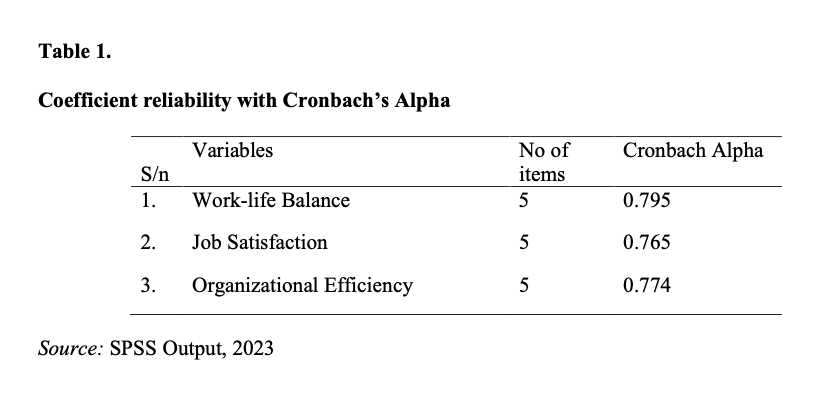
Result and analysis
Data cleaning and preliminary analysis
The following preliminary data analysis was performed before the data was used for the analysis; this was done by the researcher to ascertain that the data is free from all forms of multivariate assumptions.
Missing Data
The data set had some missing values in it but since this did not amount to 50% of the total data, the missing values were replaced with the values gotten from the series mean test that was carried out in SPSS.
Test for Normality
Test of normality for the variables was statistically and graphically done, skewness and kurtosis values were generated for all the variables in the study as seen in table 4.2. A rule of thumb for normal data is that skewness and kurtosis should not exceed + or – 2.58 (Hair et al, 2010). All the variables were normally distributed as shown by the table.
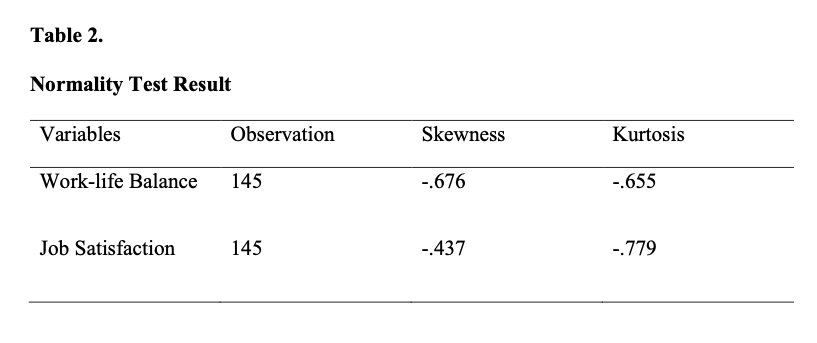
Source: SPSS 2023
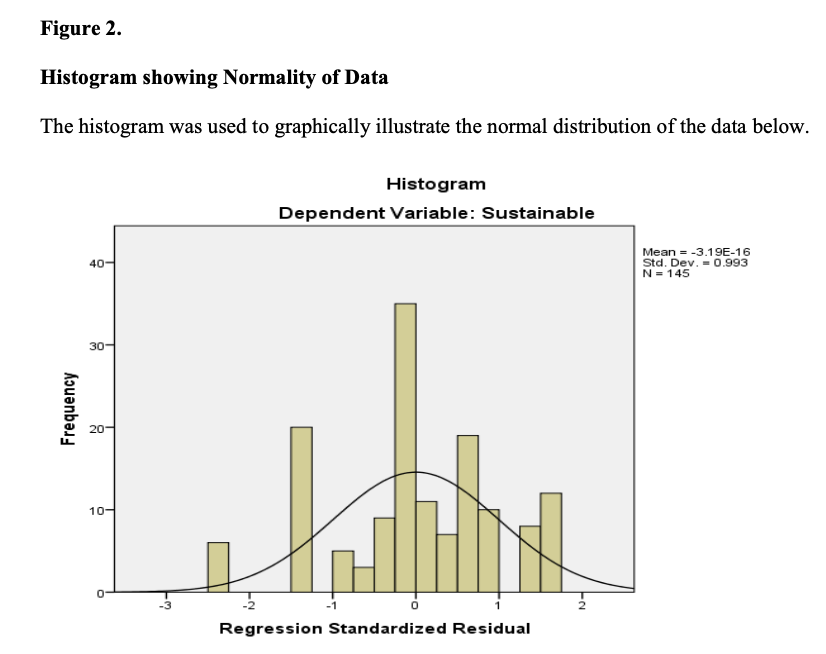
Test for Linearity
The Pearson Product Moment Correlation was used to test the relationship among variables of the study. The result shows that there is a linear relationship among variables of the study as shown by Table 3.
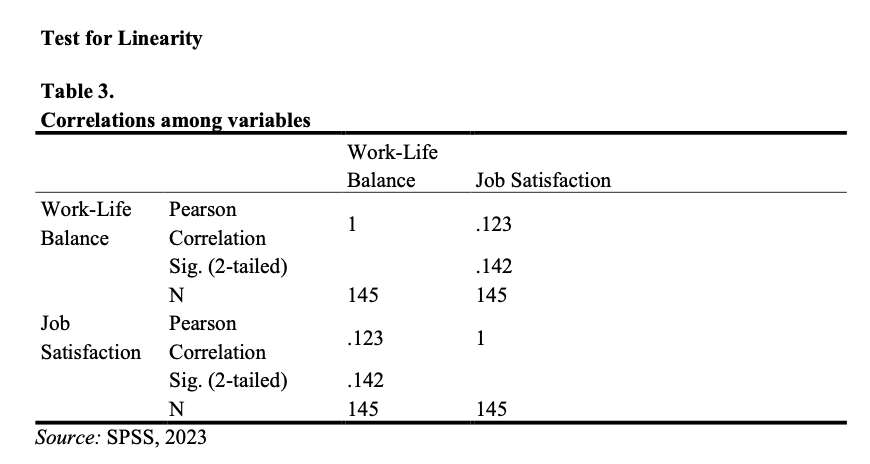
The result in the table above shows that there is a linear relationship among variables of the study. Figure 3 shows the graph illustrating the relationship between the variables of the study.
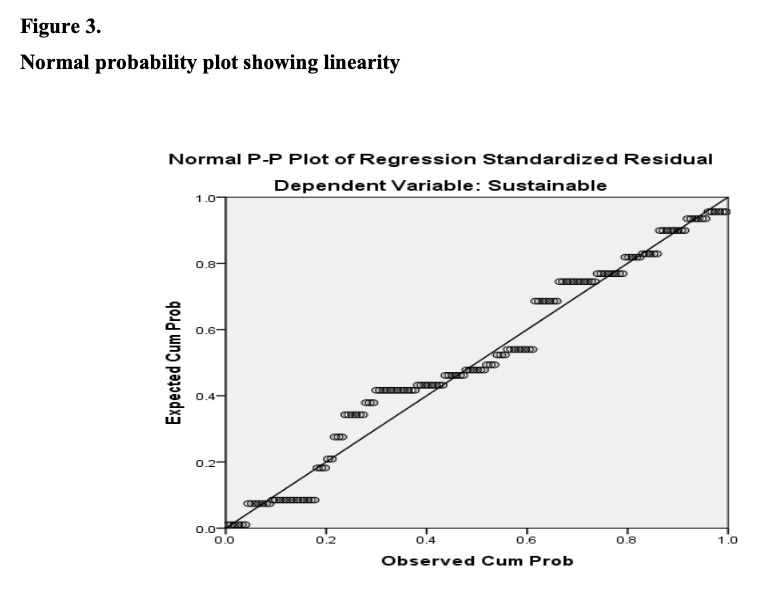
Test of Hypotheses:
Hypothesis 1:
H01: Work-life balance does not significantly influence organizational efficiency in selected business organization in Calabar, Cross Rivers State

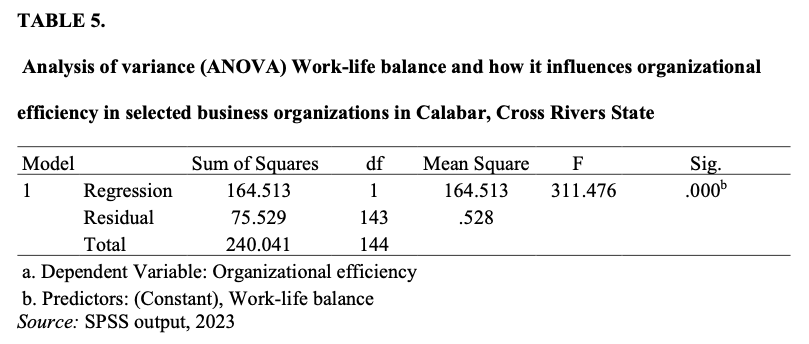
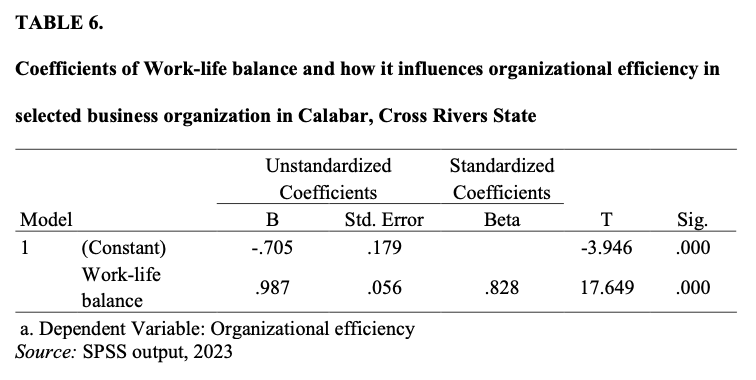
The result show the effect of work-life balance and how it influences organizational efficiency in selected business organizations in Calabar, Cross Rivers State, the table which is the model summary reveals that the relationship between both variables is 82.8 percent (as seen in the R column). The R2 value (0.685) indicates that 68.5% of the dependent variable (organizational efficiency) can be explained by the independent variable (work-life balance). This is very significant. The value of the adjusted R-square of .683 indicates goodness of fit of the data to the model.
The F-test (311.476, p<0.05) of the relationship in Table 5 indicates that the overall prediction of the independent variable to the dependent variable is statistically significant, therefore, the regression model provides sufficient evidence to conclude that work-life balance influences organizational efficiency. The “sig” column in the table reveals that work-life balance have significant influence on employee performance. This is as a result of the fact that “sig” = 0.000, p>0.05.
Table 6 above shows the coefficient table which provides more information as to how work-life balance influences organizational efficiency in selected business organizations in Calabar, Cross Rivers State. The “sig” column in the table reveals that the “P” value is less than 0.05 which means that the independent variable is statistically significant. The result shows that there is significant influence of walk-life balance on organizational efficiency (Beta = 0.828, P<0.05). Therefore, the null hypothesis was rejected.
Hypothesis 2:
Ho2: Job satisfaction does not significantly influence organizational efficiency in selected business organizations in Calabar, Cross Rivers State
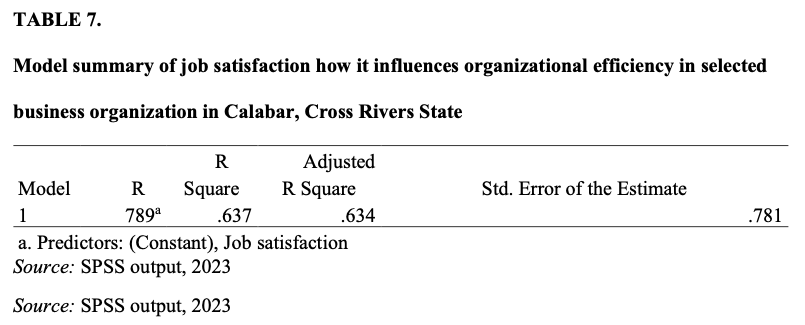
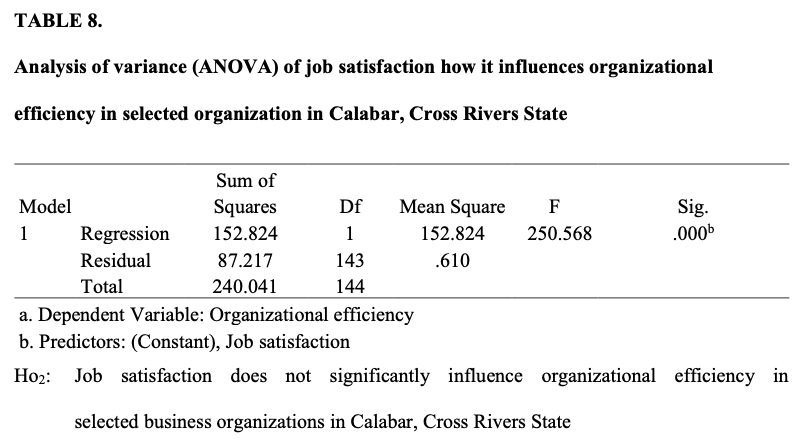
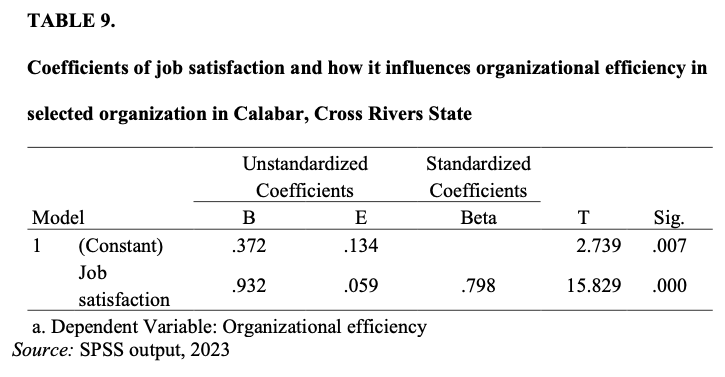
The result show the effect of job satisfaction and how it influences organizational performance in selected business organization in Calabar, Cross Rivers State the table which is the model summary reveals that the relationship between both variables is 78.9 percent (as seen in the R column). The R2 value (0.637) indicates that 63.7% of the dependent variable (organizational efficiency) can be explained by the independent variable (job satisfaction). This is very insignificant. The value of the adjusted R-square of .634 indicates goodness of fit of the data to the model.
The F-test (250.568, p<0.05) of the relationship in Table 8 indicates that the overall prediction of the independent variable to the dependent variable is statistically significant, therefore, the regression model provides sufficient evidence to conclude that job satisfaction influences organizational efficiency. The “sig” column in the table reveals that job satisfaction has a significant influence on organizational efficiency. This is as a result of the fact that “sig” = 0.000, p<0.05.
Table 9 above shows the coefficient table which provides more information as to how job satisfaction influences organizational efficiency in selected business organizations in Calabar, Cross Rivers State. The “sig” column in the table reveals that the “P” value is less than 0.05 which means that the independent variable is statistically significant. The result shows that there is a significant influence job satisfaction on organizational efficiency (Beta = -0.798, P<0.05). Therefore, the null hypothesis was rejected.
Discussion of findings
The result of the first hypothesis reveals that walk-life balance has significant influence on organizational efficiency (Beta = 0.828, P<0.05). In line with the finding Andriyanty et al. (2021) stressed that work-life balance as an organizational philosophy is implemented through work from home, and it creates harmony and balance between work responsibility and life of employee. Responses from respondents indicate 82 percent of respondents agreed that remote work in the areas of finance, ICT and HR has helped employee to achieve harmony and have a balance between work responsibility and personal life. The implementation of work-life balance allows task consistency to improve organizational performance and encourages employee to achieve set goals. The essential practice of work-life balance enhances individual wellbeing with a win-win result. Time flexibility has influenced the practice of work-life balance and this helped management to achieve positive outcome. Hence, organizational efficiency is sustained through engagement of employees to potential goals of the organization
The result of second hypothesis indicates that job satisfaction has significant influence on organizational efficiency in selected business organization in Calabar, Cross River State (Beta = -0.798, P<0.05). In consensus with the findings Golden (2006) stressed that an increase in remote work result in increase in job satisfaction. Therefore, responses from respondents reveal that 76 percent of the respondents had a positive opinion that work from home policy of organization increase job satisfaction and increase in autonomy. Turnover rate is effectively controlled through job satisfaction in the organization. Satisfied workers are able to enhanced productivity as employee feel contented with organizational position. Financial benefits are a stronger contribute to greater job satisfaction due to absent of commuting to work. Effective time planning is a resource for working from home which allows for flexibility and scheduling of appointment, and completion of assigned task. The culture of trust has influenced supervisor to assigned task to employee to engage in e-working. Employee is highly satisfied working remotely based on the provision of adequate tools and technology. Hence, manager’s decision on job efficiency allows HRM activities to support work-life balance
Conclusion and Recommendations
Greater remote work and employee with remote work options are effectively enhanced efficiency in organization. this study reviewed work-life balance and job satisfaction as enablers of remote work culture that is sustainably practiced in organizations. Remote work in areas of finance, ICT HR are satisfactorily performed based on supportive policies of the organization and has helped the organization to achieve productive efficiency in the organization. Though, the outbreak of COVID-19 forcefully introduced the inevitability of remote work, it is however adopted based on technological advancement and as competitive approach to achieve organizational objectives among organizations.
Based on the findings, the recommendations are adduced:
- Work-life balance should be a consistent HR practice for enhancing higher productivity based on commitment and motivation of employee to work remotely, and have flexibility to set a balance between work responsibility and personal life
- The remote work practice should be job satisfactory defined to sustain the engagement of employee, enhanced productivity, offers greater financial benefits in order to minimize turnover of employees where adequate tools and technology are for job efficiency
Bibliography):
Andriyanty, R., Komalasari, F. & Rambe, D. (2021). The effect of work from home on corporate culture mediated by motivation, work behavior, and performance. Journal of Applied Management, 19(3), 522-624
Asatiani, A., Hämäläinen, J., Penttinen, E. & Rossi, M. (2021). Constructing continuity across the organisational culture boundary in a highly virtual work environment. Information Systems Journal, 31(1), 62-93.
Brenan, M. (2020). COVID-19 and Remote Work: An Update. https://news.gallup.com/poll/321800/covid-remote-work-update.aspx
Davis, C. W., & Myers, K. K. (2019). Past work experience and organizational assimilation in non-profit organizations. Non-profit Management and Leadership, 29(4), 569-588
Chow, I. H. & Keng-Howe, I. C. (2006). The effect of alternative work schedules on employee performance. International Journal of Employment Studies, 14(1), 105–131
Chernyak-Hai, L. & Rabenu, E. (2018). The new era workplace relationship: Is social exchange theory still relevant? Industrial and Organizational Psychology, 11(3), 24-35
Cooper, C., & Kurland, N. (2002). Telecommuting, professional isolation, and employee development in public and private organizations. Journal of organizational behavior, 23(4), 511-532.
Donnelly, R. & Johns, J. (2020). Recontextualising remote working and its HRM in the digital economy: An integrated framework for theory and practice. The International Journal of Human Resource Management. 14(4), 13-26
Brynjolfsson, E. (2020). COVID-19 and remote work: An early look at US Data. National Bureau of Economic Research, https://www.nber.org/papers/w27344
Bouziri, H., Smith, D. & Descatha, A., 2020. Working from home in the time of COVID-19: how to best preserve occupational health? Journal of Occupational and Environmental Medicine, 77(7), 23-35
Felstead, H. & Henseke, G. (2017). Assessing the growth of remote working and its consequences for effort, well‐being and work‐life balance. New Technology, Work and Employment, 32(3), 195–212
Grant, C., Wallace, L., Spurgeon, P., Tramontano, C., & Charalampous, M. (2019). Construction and initial validation of the e-work life scale to measure remote e- working. Employee Relations, 41(1), 16–33
Golden, T. D., Veiga, J. F., & Simsek, Z. (2006). Telecommuting’s differential impact on work family conflict: Is there no place like home? Journal of Applied Psychology, 91,1340-1350.
Henttonen, K., & Blomqvist, K. (2005). Managing distance in a global virtual team: The evolution of trust through technology-mediated relational communication. Strategic Change, 14(4), 107–119.
Johnson, M. W. & Suskewicz, J. (2020). Does your company have a long-term plan for remote work? Harvard Business Review https://hbr.org/2020/07/does-yourcompany-have-a-long-term-plan-for-remote-work
Khapova, S. N., Arthur, M. B., Wilderom, C. P., & Svensson, J. S. (2007). Professional identity as the key to career change intention. Career Development International, 12(7), 584-595
Klopotek, M. (2017). The advantages and disadvantages of remote working from the perspective of young employees. https://ideas.repec.org/h/tkp/mklp17/535.html
Kossek, E. E., Lautsch, B. A., & Eaton, S. C. (2006). Telecommuting, control, and boundary management: Correlates of policy use and practice, job control, and work-family effectiveness. Journal of Vocational Behavior, 68(2), 347-367.
Kowalski, G. & Slebarska, K. (2022). Remote Working and Work Effectiveness: A Leader Perspective.International Journal of Environmental Research in Public Health, 19, 1-12
Kowaslski, K. B., Aruldoss, A., Gurumurthy, B. & Parayitam, S. (2022). Work-from-home productivity and job satisfaction: A double-layered moderated mediation model. Sustainability, 14, 1-29
Madhusudhan, V., & Nagaraju, K. (2013). Work life balance of teaching faculty with reference to Andhra Pradesh Engineering Colleges. Global Journal of Management and Business Studies, 3(8), 891-896.
Madsen, S. R. (2011). The benefits, challenges, and implications of teleworking: A literature review. Culture and Religion Review Journal, 20(1), 1-13
Mahesh, B. P., Prabhushankar, M. R., Chirag, S. K., & Amit, V. S. (2016). A study of work-life balance and its effects on organizational performance. International Journal of Engineering Research and Advanced Technology, 2(1), 344-349
Martin, B., & MacDonnell, R. (2012). Is telework effective for organizations? A meta-analysis of empirical research on perceptions of telework and organizational outcomes. Management Research Review, 35(7), 602-616.
Mason, B. (2020). Is remote working really so bad? The benefits of working from home during Covid-19. https://www.employment-studies.co.uk/news/remote-working-really-so-bad-benefits-working-home-during-covid-19
Moss, R. (2020). Half of workers expect remote working reversal after COVID-19. https://www.personneltoday.com/hr/remote-working-after-covid-19-Coronavirus/X
Mohite, M. D., & Kulkarni, R. V. (2019). Job satisfaction factors of employees in a virtual workplace: Review. International Journal of Trend in Scientific Research and Development, 1, 38-42
Ozimek, A. (2021). Future workforce report 2021: How remote work is changing businesses forever. Upwork. https://www.upwork.com/research/future-workforcereport
Parungao, A. (2020). The future of remote work after COVID-19: 3 common predictions. https://www.ekoapp.com/blog/the-future-of-remote-work-after-covid-19-3-common-predictions
Poulose, S. & Sudarsan, N. (2018). Work-life balance: A conceptual review. International Journal of Advances in Agriculture Sciences, 3(2), 5-9
Sellar, T. & Peiris, M. (2021). Effect of work from home on job satisfaction in response to the outbreak of COVID-19. South Asian Research Journal of Business and Management. 3(5), 112-120
Smith, S., Patmos, A., & Pitts, M. (2018). Communication and teleworking: A study of communication channel satisfaction, personality, and job satisfaction for teleworking employees. International Journal of Business Communication, 55(1), 44– 68
Spicer, A. (2020). Organizational culture and COVID-19. Journal of Management Studies, 57(8), 1737–1740. doi:10.1111/joms.12625
Sok, J., Rob, B. & Debbie, T. (2014). Positive and negative spill over from work to home: The Role of organizational culture and supportive arrangements. British Journal of Management 25(3), 456–472
Sucheran, S. & Olanrewaju, O. A. (2021). The effect of remote working on employees productivity levels in South Africa. Proceedings of the International Conference on Industrial Engineering and Operations Management. Rome, Italy, August 2-5
Roopavathi, S. & Kishore, K. (2021). The impact of work life balance on employee performance. Journal of Interdisciplinary Cycle Research, 12(10), 31-39
Torten, R., Reaiche, C. & Caraballo, E. (2016). Teleworking in the new millennium. The Journal of Developing Areas, 50(5), 317–326
Toniolo-Barrios, M. P. L. (2020). Mindfulness and the challenges of working from home in times of crisis. Business Horizon, 12, 5-15
Virick, M., DaSilva, N., & Arrington, K. (2010). Moderators of the curvilinear relation between extent of telecommuting and job and life satisfaction: The role of performance outcome orientation and worker type. Human Relations, 63, 137– 154.
Wienclaw, R. (2019). Telecommuting. Salem Press. https://search.ebscohost.com/login.aspx?direct=true&db=ers&AN=89185784&lang
Woolfolk, A. (2010). Educational psychology. New Jersey: Pearson
Author: Welle Lawrence, student LIGS University
Approved by: Catherine Muthu, lecturer LIGS University



